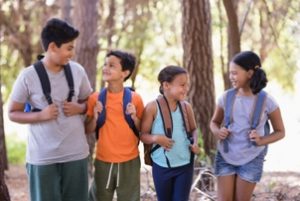NJ Teachers of English to Speakers of Other Languages/
NJ Bilingual Educators
ARTICLES
From the Editor: Roselyn Rauch- Huh?
President’s Message: Caia Schlesinger- Thank You!
Vice President: Maggie Churchill- Confessions of a WIDA Representative
The Daily Journal Vineland: Deborah M. Marko- Vineland ESL, Bilingual Programs Win State Honors
Conference Coordinator: Sandee McBride- Spotlight on Poster Sessions
Congratulations to Scholarship and Award Winners
Spring Conference Liaison: Tina Kern- Refresh, Regenerate, Rejoice
Representative-at-Large/ Liaison to Chapters and NJEA: Joyce Farr- Reflections of a Transplanted Shoot
Guest Reviewer: Elsa M. Mena- Epic!, ChatterPix, and Dreambox
Guest Contributor: Natasha Agrawal- Morocco- A Marvelous Multilingual Mosaic
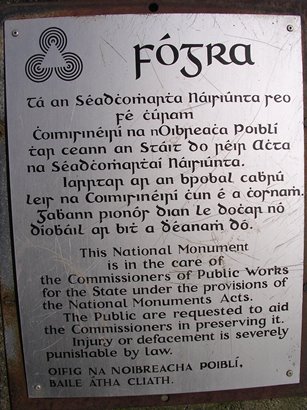 From the Editor:
From the Editor:
Huh?
By Roselyn Rauch
My brain is tired. Sights and sounds that I do not comprehend bombard my eyes and ears.
What is that? What does it say?
I see my alphabet’s letters; albeit that some have cute little designs and curlicues – like we used to dot our letter i’s with hearts or put smiley faces in our o’s. These are not quite the same.
Here I am traveling through Ireland, Scotland, and Iceland among people who look like me. Forgive me if this is not politically correct in our sensitive “climate”. Nevertheless, it is an accurate observation.
I am a literate educated adult; I know why I am here and I understand that there are major differences between my home life and the lands through which I travel.
The “leprechaun” I spoke to in Dublin, Ireland, sounded as if he needed to cough up a throat-full. The guide on our Belfast tour in Northern Ireland spoke Gaelic, the olde language, and I thought that his lower jaw would come unhinged. In Lerwick, Shetland Islands, Scotland, the language was a little sing-songy; if that makes sense to you.
In Reykjavik and Akureyri, Iceland, the native speech reminded me of Statler and Waldorf, characters in the original Muppets show. Google them. Iceland has a strong Nordic influence, as Iceland was once a part of Norway.
So what is a traveler to do? Be grateful that many of the signs are also in English? Know that many of the citizenry speak English?
Certainly, this brings me to our ESL (English as a Second Language) and bilingual students. Sure, I am preaching to the choir here but think about our charges that come from places whose alphabetic systems look nothing like ours. Or, those SLIFE kids (Students with Limited or Interrupted Formal Education) whose native language skills have barely scratched the surface. And, so many don’t look like us, dress like us, or smell like us or anybody else in their new environment.
So what can they be thinking? These are children or adults without much, if any, worldly experience.
Reverse it.
They feel the same: the sights, sounds, and smells and flavors are not what they know, and may be repugnant to them. They are experiencing true culture shock, possibly with a hefty dose of fear of the unexpected and unpredictable.
Yet every day we walk into our classrooms and take on those challenges. First, and foremost, we deliver a dose of TLC (Tender Loving Care) to bring down those affective filters. We move on, little by little, step by step, to educate these students to become productive members of society. We usually succeed barring any unforeseen variables.
Wherever I travel and speak with new-found friends, we always exchange somewhat personal information. When I tell them that my field is second-language acquisition, ESL, they look at me in wonderment. They query how it is possible to teach English to students whose languages I do not know; and that a class can have multiple languages represented. They think that I do the impossible.
You all know that with the right tools, knowledge, and mindset, it is possible. You create that magic in your classrooms every day. You are applauded for your dedication and hard work.
I hear it worldwide.
So read on. In this summer edition of Voices, we recap our Spring Conference, a truly amazing three days of keynote speakers, workshops, contact with publishers, and, of course, networking.
It is the networking here at Conference, and through the Hotlist, that helps us keep our sanity through these crazy educational times. This is one reason why I always strongly encourage Voices’ readers to read all of the Features and Special Interest Group (SIG) reports. You never know what may resonate with you, and, somehow, some way, and somewhere, what is reported herein may come to you.
Looking forward…
Roselyn Rauch, Ed. D, was the editor of Voices and a retired ESL/ESL Resource Teacher for the Paterson Public School District. She is a consultant with ESL Unlimited.
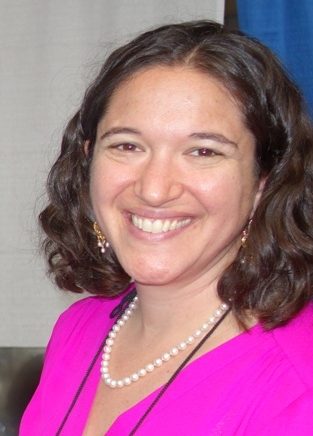 President’s Message:
President’s Message:
Thank You!
By Caia Schlesinger
On Saturday, June 23, 2018, the dedicated volunteer members of the NJTESOL/NJBE Executive Board gathered at Rutgers University Graduate School of Education to begin planning for the upcoming year. One of the topics on our agenda was our annual Spring Conference.
It was daunting to take on the role of Conference Chair, but I am glad that I did. I am so grateful for the hard work of our volunteer board members. Without these dedicated volunteers, we would not be able to have our wonderful Spring Conference. Our organization also would not be able to run as efficiently as it does without the behind the scenes hard work of our business administrator, Gwen Franks. I also would like to thank our Past-Presidents, Sandee McBride and JoAnne Negrin, and our Advocacy Representative, Elizabeth ‘BJ’ Franks, for mentoring me throughout this process.
Apart from our Executive Board and volunteers, I would like to take the opportunity to thank everyone who attended and presented at the Spring Conference. Thank you so much for taking time out of your busy schedules in order to come attend and/or present. I would like to thank our keynote speakers, featured speakers, Special Interest Group (SIG) Representatives, and presenters for sharing their expertise with us.
Some of the presentations from the conference are on the website. Please check this link for presentations by our featured speakers, as well as the New Jersey Department of Education’s (NJDOE’s) presentation, State Initiatives in Bilingual/ESL Education.
Thank you to those of you who filled out our online survey. Stay tuned for the updates to our 2019 Spring Conference: May 29th, May 30th, and May 31st, 2019, at the Hyatt Hotel in New Brunswick. Registration will open September 1st, 2018, and proposals will be due by October 15th, 2018.
Caia Schlessinger, President, NJTESOL/NJBE, ESL Teacher, Highland Park School District cschlessinger@njtesol-njbe.org
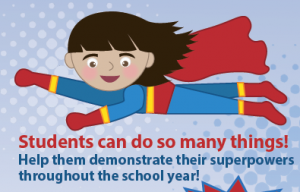 Vice President
Vice President
Confessions of a WIDA Representative
By Maggie Churchill
For the past five years, I was closely involved with the WIDA organization. I presented at WIDA conferences; served as a member of the WIDA Local Education Agency (LEA) Advisory Committee (2015-2018); and participated in dozens of pilot studies, focus groups, surveys, and conference calls to review WIDA assessments, standards, and products and offer feedback from the classroom teacher’s perspective. As my tenure comes to an end, I would like to share some of my key understandings gathered from my service over the years.
1. The WIDA Standards are our standards. Every state is required to have English language development (ELD) standards. States either write their own (CA, NY, TX), or join WIDA (39 states). In New Jersey, ESL teachers teach under two sets of standards: The New Jersey Student Learning Standards (NJSLS), and the WIDA English Language Development (ELD) Standards (2012). Both sets of standards are equal in regards to curriculum, instruction, and assessment. The WIDA ELD Standards are not secondary in importance. These standards are aligned in New Jersey Department of Education (NJDOE) Model Curriculum.
2. Each state is DIFFERENT. Some states use WIDA assessments, but not their standards. States set their own assessment schedule. States determine target scores for exit criteria on the ACCESS for ELLs 2.0 assessment. States decide which data fields are required for collection. Much is based on our state’s ESSA plan (Every Student Succeeds Act). Each state has its own specific page–click on the map from the home page at https://wida.wisc.edu to find New Jersey’s page.
3. What is on the WIDA website is NOT the final answer. WIDA is a consortium of states, but does not hold administrative authority. State education agencies (SEA’s) determine policy, guidelines, and procedures to follow for entry, testing, and exit. Turn to the NJDOE Bureau of Bilingual/ESL Education for guidance and answers at http://www.state.nj.us/education/bilingual/
4. The Download Library is your treasure chest. Everything is there: the WIDA ELD Standards, Can Do Descriptors, a long list of translated letters for ACCESS for ELLS 2.0 scores, parent guides, and the list goes on. At the top of the WIDA homepage, click on Download Library just under the social media icons. I urge you to read the briefings and reports under the Research section, in particular Academic Achievement for English Learners: What Can We Reasonably Expect?
5. Participating in WIDA opportunities makes you a better practitioner. I have worked with many WIDA researchers over the years. You can participate in WIDA research through focus groups, surveys, and test item sampling. They appreciate hearing from classroom teachers, and, this, in turn, improves their products and services. Attending and presenting at four WIDA conferences has had a profound impact on my instructional practice and deepened my understanding of how students develop language through the presentation of academic content.
6. WIDA has extensive professional development resources online. From the WIDA homepage, under Professional Learning, check out Educator Resources. You can watch webinars, view modules, and start a professional learning community with your colleagues. Subscribe to WIDA News at https://www.wida.us/news/ and read their Focus Bulletins, archived at https://www.wida.us/professionaldev/educatorresources/focus.aspx.
Also See: Using ACCESS Score Reports
Maggie Churchill, Vice President of NJTESOL/NJBE
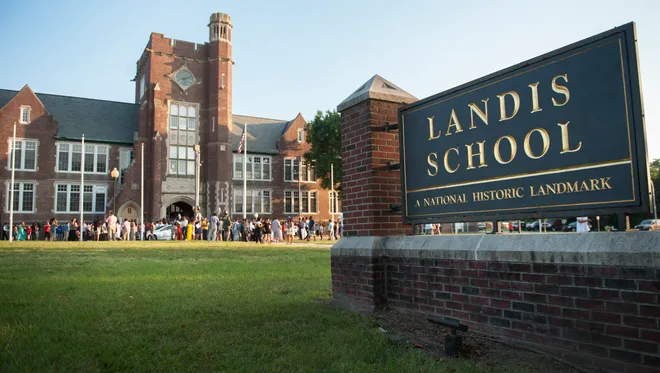
(Photo: Chris LaChall/Staff Photographer)
Vineland ESL, Bilingual Programs Win State Honors
By Deborah M. Marko, the Daily Journal
Published 10:18 a.m. ET June 6, 2018 | Updated 10:28 p.m. ET June 6, 2018, Copyright 2018, The Daily Journal and The Daily Journal Reprinted with permission. All rights reserved.
VINELAND – Building on its success, the school district now boasts of four Model Programs serving bilingual and English as a Second Language students.
The district’s K-5 bilingual program was the first to be honored, earning the Model Program designation from the state Department of Education last year.
“We were the only district south of Princeton to receive this honor,” JoAnne Negrin, supervisor of ESL, world languages, bilingual education and performing arts, told The Daily Journal. For the 2018-2020 cycle, the bilingual program maintained the designation.
The state also awarded Model Program status to the district’s K-5 English as a Second Language, 9-12 bilingual and 9-12 English as a Second Language programs.
“It’s terrific for us as a district in terms of celebrating and validating what we do,” Negrin said, noting more than 40 home languages are spoken by the district’s ESL students.
As a Model Program district, Vineland will host other school districts interested in implementing similar programs.
“One of things that’s very special about what we do here is the real emphasis on building academic knowledge in their first language; I think that’s really the secret to our success,” Negrin said.
“It’s welcoming people for who they are, giving them access to the higher-level academics that if you had to do it through filtered English, it would be much more difficult to achieve.”
“People will say, ‘How are they ever going to learn English if they’re learning in their native language all day?’” she said. “What I always tell people, ‘We are all about the content — if we are teaching the content and if the students are on grade level with the content, the language will come.
“If you sacrifice the content for the language, you’re very likely to end up with neither,” Negrin said.
The Model Program notifications came in an email, and Negrin said she eagerly shared the good news with everyone within earshot.
“I screamed in my office,” she said.
The recognition from the state “goes a long way toward creating a cohesive program and to really fueling the enthusiasm of our staff and our students,” Negrin said.
“The application process to be a Model Program is extensive and rigorous,” she said, explaining the district must meet state benchmarks for academic progress in language arts and math.
“This is quite challenging for English language learners, as students often come with gaps in their education, and the language arts portion of the test is given only in English,” she said. Negrin added “not only have we met those state targets, but preliminary data analysis of students who took the PARCC in grades 3-5 show that ESL students have significantly higher growth in all areas than native English-speaking Vineland Public School students.”
“Students in the bilingual program (who receive their core content instruction in Spanish) have growth on the PARCC that is significantly higher than students in English-medium classes who take ESL,” Negrin said. “Those results are incredible, and turn the narrative that ‘these kids can’t’ on its head.”
“They can, and they are,” Negrin said.
“The No. 1 predictor of how quickly a student is going to be on grade level in English, is how literate they are in their first language,” she said. “We never want people to tell parents not to speak to their child in their language.”
The school district encourages students to maintain their bilingual skills with programs including the Seal of Biliteracy. In 2014, Vineland was one of seven pilot districts in the state to offer the program that publicly acknowledges high school students who are highly proficient in one or more languages in addition to English.
There will be 61 VHS Class of 2018 diplomas with the seals.
“We allow the students to test for the Seal of Biliteracy in a home language that is not a language that they’ve taken in our school system,” Negrin said. “We have students who got the Seal of Biliteracy in Turkish, Hindi, Hebrew, so many other different languages that they’ve brought with them.”
“We’ve been able to help celebrate them for that,” she said. Negrin commended the hard work of the staff, who must be flexible.
The demands on the ESL and bilingual programs change annually depending on enrollment. “The thing that I tell my staff that you need to be successful in these departments is a tolerance for ambiguity and a sense of adventure,” she said. “We need to respond to the needs of the kids.”
The Vineland school board honored the staff of the district’s Bilingual and English as a Second Language programs during the June 6, 2018 meeting. (Photo: Deborah M. Marko)
The district’s bilingual/ESL staff are:
- Barse: Aimee DeLucia.
- D’Ippolito/Winslow: Annette Lower and Karolina Mills.
- Durand: Richard Bermudez.
- Johnstone: Melissa Capelli, Dialys Rodriguez, Desiree Vargas, Lissette Soto, Shantelle Perez, Maria Garcia, Jessica Mercado Santana, Carol Farinaccio, Cheryl Cline, Amy Traberman, Hanna Jakucki and Isabelita Rivera.
- Mennies: Elena Greenwood. • Sabater: Lilia Beneat, Raysa Collado, Omaira Capriotti, Angela Vega, Cynthia Sagardia, Gustavo Curbelo Olivares, Marilyn Cortes, Marquis Strickland, Ines Mercado, Marisol Colon, Dixie Bacon, Allison Heather, Jina McCauley, Valeria Fogarino, Alfreda Lyden, Maria Bachinsky, Shirley Santos, Wanda Berrios and Joanne Ramos.
- Vineland High School: Mary Angelo-Moi, Nixida Maldonado, Jim Firn, Vlada Jackson, Sonya Bertini, Maria Alvarado, Lourdes Ayala, Luzmila Badillo-Gualdron, Provis Leon and Alicia Serrano.
Deborah M. Marko; 856-563-5256; dmarko@gannettnj.com : Twitter: @dmarko_dj
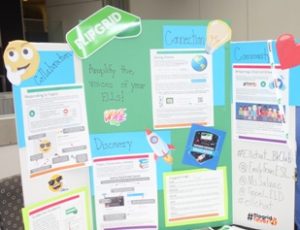 Conference Coordinator:
Conference Coordinator:
Spotlight on Poster Session Exhibitors
by Sandee McBride
Venturing up the New Brunswick Hyatt staircase brought NJTESOL/NJBE’s annual Spring Conference attendees to our amazing poster sessions. This year’s topics included some of the following topics: cross-curricular sheltered English instructional units, the scaffolding of social studies units, and breaking down the writing process into steps our students can more easily follow. But wait, there was more.
At these poster sessions, attendees were able to visit teachers and administrators who explained the use of content area sentence frames; Flip Grid technology for authentic social and academic language (https://resources.flipgrid.com/ ); academic discussions and writing with culturally and linguistically diverse exceptional students; and the influence of personality and affective filters in native and second/other languages.
The outstanding poster sessions drew record numbers of conference goers who were able to gain knowledge to implement into their own classrooms. Others examined the sessions with plans to turn-key the ideas and strategies to their colleagues. It was a wonderful, rewarding experience for all.
A poster session is an easy way to share your best lesson, strategy, and/or resources with other educators. We learn from one another. Consider submitting your poster session proposal for next year’s conference. Check our website https://njtesol-njbe.org/ for conference information as it becomes available.
Sandee McBride, NJTESOL/NJBE 2019 Conference Coordinator, Adjunct, Rutgers University and Kean University
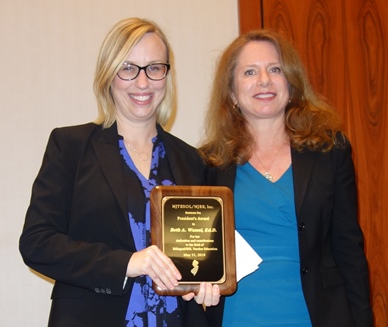
President’s Award – Dr. Beth Wassell, Rowan University
Scholarship and Award Winners
Congratulations to:
2018-2020 Model Bilingual/ESL Programs Recognized by the NJDOE:
- Atlantic City
- Franklin Township
- HoLa Hoboken Dual Language School
- Howell
- Linden
- Passaic
- Vineland
NJTESOL-NJBE Awards
- Advocacy Honoree- Kenneth Bond, NJDOE Bureau of Bilingual/ESL Education
- Seal of Biliteracy Superintendent of the Year- Dr. David Roman, Perth Amboy School District
- Certificates of Recognition- Maria Romero, Carteret School District & Dawn Arthur, Voices Layout Artist
- Fourth Grade English Writing Challenge- Mahi Patel
- Eighth Grade English Writing Challenge- Tasnim Omar Agha
- Raquel Sinai Newcomer Scholarship- Estephania Corgelas
- Pedro J Rodriguez High School Scholarship- Gelis Tigre
- Seal of Biliteracy Scholarship- Camila Vega
- Praxedes Leon Seal of Biliteracy Parent Award- Sonia Martinez
- Higher Education Scholarship- Areeba Syed
- Dr. Jessie Reppy Memorial Graduate Student Scholarship- Daniela Ceballos Marulanda
- Elizabeth Claire Teacher’s Grant- Linda Waterman
- Fred Carrigg Leadership Award- Principal Mike Fiorello, Westwood Regional School District
- President’s Award- Dr. Beth Wassell, Rowan University
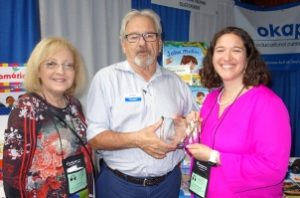 Spring Conference Liaison
Spring Conference Liaison
Refresh, Regenerate, Rejoice
By Tina Kern
I watch as they remove the curtains and break down the booths with pipes sticking up precariously, completely decimating the beautiful area that housed our exhibitors and helped create the magic that is the NJTESOL/NJBE Spring Conference. As they take away the tables, the chairs, the signs, and other decorations, my mind refuses to let the images disappear. I try to hang on to the memories as we pass each area in the hotel. The visions fade away and the rooms return to their previous mundane state. We gather our bags and books, say our goodbyes and go home, with the promises of trying our new materials and methods filling our heads.
Did you learn new methods? Did you tuck away those teaching secrets that we reveal to our students to stoke their curiosity? Did you experience the workshops and the energy around the Atrium as our exhibitors shared their newest and best with you?
I want to shout out to those wonderful sponsors that supported our conference and to the ESL/bilingual educators and students:
Diamond Sponsor
Silver Sponsors
- Lynda Dixon Books (Center for the Collaborative Classroom, Pacific Learning, Capstone, Mindplay)
- Okapi Educational Publishing
Silver Sponsors cont.
Keynote Sponsors
I also want to thank all of our exhibitors for providing their materials and supporting our conference. Please think of them as you choose your materials for next year. I have already reached out to a few of them for samples and ideas with which to bring our new Bilingual Language Arts program forward, provide outstanding instruction and help make concepts easily comprehensible, as so many of you on the Hotlist ask about the best instructional materials for your grade levels.
Please always feel free to reach out to me for contacts for various companies that offer ESL and bilingual material and technology. My email is tkern@njtesol-njbe.org. Contacting the exhibitors that support our conference is a great way for you to receive information (and sometimes samples), and at the same time, reinforce to them how important they are to us during our conference. In addition, if there was an exhibitor that you know who didn’t attend, and you think they have materials that would be beneficial to our members, please let me know. Together we make the conference a great experience.
Soon after the conference, we say goodbye again, this time to our students. We make promises as we try to hold the memories of their youthful enthusiasm. Was it just yesterday when we introduced ourselves to a sea of nervous demeanors and stoic posing? Now some of my students are graduating and some are going on to County College. This seems almost a miracle considering how some of them came to us so traumatized and unsure of their futures just a few years ago.
The atmosphere in our classes has morphed as the students appreciate the importance of education in their lives. Of course, we have those who cannot embrace the changes as easily as some peers – and it always is a great source of frustration not to be able to reach them. They left school in search of something beyond the scope of education. They saw the short-term goals and were unable to wait patiently for their education, to take the time to reach what seemed like an elusive dream.
This year, with the addition of Bilingual Language Arts to our ESL/bilingual program in our school, we have provided opportunities for students to immerse themselves in more content area subjects to boost their literacy skills. What a feeling I have when I peruse my class now that I am teaching Bilingual Language Arts, and think about how far our students have come in their education. I observe the class and I always flash back to my first week in the school after my transfer, standing in front of 25 angry students. My goals were basic and immediate. The curriculum was dated and not pertinent to the students with trauma and interrupted learning. My most immediate goal was to “teach them school”: staying in their seats, raising their hands, not throwing pencils to each other… and other skills they didn’t learn from the gaps in their education.
Fast forward: The ESL/bilingual students are integrating content area vocabulary across different subjects. They are working beyond expectations and enjoying success on various levels. At first, our students tried to look like their American-born counterparts as they tried to emulate their dress and behavior. Though still looked upon as “different”, they tried to find their places in the school community. Traveling from class to class with their peers, they peeled away to their bilingual and ESL classes, honing basic skills. Now they enjoy classes designed to elevate their skills and propel them into more content area classes. During my workshop, I shared some websites and methods to differentiate as some of our students still struggle with basic material, while others are embracing the spiraling curriculum that encompasses more complex skills.
Though our conference and the school year are over, my mind is still internalizing ideas and designing lessons that soon will be part of the new school year. This summer I will read educational material, scour the websites at odd hours, and think intermittently about lessons, perhaps jotting down ideas. As the days of summer recede, though, I will think a little more about the wonderful material and lesson ideas I experienced during conference. For now, I anticipate longer days of less work, later starts to those days, and cups of iced coffee and tea enjoyed lazily.
I wish all of our members, and supporters a healthy summer. See you soon.
Tina Kern, Liaison
 Representative-at-Large
Representative-at-Large
Reflections of a Transplanted Shoot
By Joyce Farr
A few weeks ago, at the NJTESOL/NJBE Spring Conference, I decided spontaneously that I needed a refresher at Dina Mansour’s Know Your Rights workshop on immigrant rights. As a warm-up activity, we were asked to describe in a single word, a word that would capture the complexity of emotion that we were experiencing on an issue that is not only heart wrenching but divisive in our nation. Outraged. That word for me has intensified over time, as I read in the news of incidents at our border. Disconcerting moral outrage. Affront to human rights. These words do not begin to translate into the reality that countless families fleeing their countries are facing as they reach the outskirts of a country they hoped would provide sanctuary. It is an indictment against our values, and against us, as a people. To hear inflammatory speeches, to watch parents broken, and men and women in handcuffs, and families ripped apart would shatter our comfortable world and upstanding moral universe.
While we applaud ourselves for the success of our statewide conference, while we endeavor to advocate for more resources, higher quality teaching, and better instructional strategies for the English learners and immigrant learners in our classrooms, and while we speak out against over-testing in New Jersey, we should recognize that these are secondary to real lives that are under threat. And no, a lawmaker does not get to describe immigration as an “existential threat” to this country because there are “not enough white kids to go around” without impunity. To what depths has this nation descended if our administration’s hardline policies brutalize and dehumanize whole people groups and more bluntly, people of color, people who do not conform to the perfect canvas of a Caucasian America?
Instead of simply seething in the face of broiling injustice, as an individual, an educator, a parent and an advocate, I refuse to sit on the sidelines of history. I run lessons on civil and human rights. I engage in debate. I take my voice and my feet to these policymakers. I want to translate the power of words into the power of a movement. Even if it started with just that one word several weeks ago.
My mother conceived, wombed and spewed me
A yellow seed onto my old motherland
An island that shaped and molded this seedling
She was my first teacher-educator
Who rooted me to my culture and my education
Steeped me in the tea of social justice
So I might brew and sprout shoots called freedom.
I am your immigrant transplant, sister of another mother
Who chose to call America my new mother
America, the land of free words and liberties
Of Bill of Rights and We the People
Like rivers coursing in my veins
Mapping out the paths to rise today
To resolve, to commit, to shape this nation.
The cry for equality thunders across this land
From the coast of California to New York island
From the Redwood Forest, to the gulf stream waters
I say to you, change must emanate from truth
From your birth pangs a hard history must be told
Must be taught in our colonized classrooms of color so diverse
With over four thousand skin tones and assorted identities.
The truth will birth a new America, a new hope, a new tomorrow.
Joyce Farr, NJTESOL/NJBE Representative-at-large, NJEA Liaison
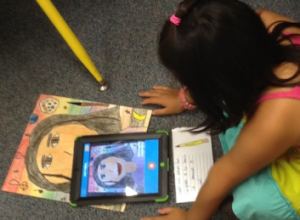 Guest Reviewer
Guest Reviewer
Epic!, ChatterPix, and Dreambox
By Elsa M. Mena
Today’s learners are functioning in an age where technology drives almost every aspect of their lives. Technology is exciting, fascinating, and ever-evolving, and when used thoughtfully, it can transform even the most mundane lesson into one that is powerful and thought-provoking. For English language learners (ELLs), increasing motivation is especially significant. Teachers must understand the major role that motivation plays in the success of language acquisition. They must continuously seek ways to increase student engagement and excitement. Technology is one great way to motivate learners while simultaneously offering a host of other benefits. For more great ideas, look at these bilingual resources and apps:
1. EPIC! is called “the Netflix of Children’s Books”, an online and app-based data of thousands of real books. EPIC! provides an unlimited selection of eBooks that can be instantly discovered, read, and shared with friends. This website offers amazing, authentic texts for students – Big Nate, Scaredy Squirrel, Fancy Clancy, The Pout-Pout Fish, Biscuit, and SO many more favorites. These texts are perfect for read-to-self, class read-alouds, or partner reading. Additionally, EPIC! offers hundreds of these books in read-aloud form. They are adding more every week which keeps the library fresh. Furthermore, Epic! can be used in all areas of curriculum due to a wide range of non-fiction books.
How to use EPIC! in your classroom?
- Whole class reading or Shared Reading: All students read and discuss the same book.
- Small group reading: Groups of students read an assigned book based on reading level or interest.
- Free reading: Students read what they want during free choice time and silent reading.
- Listening Center: Great for the “Listen to Reading” step.
- Research: For each topic, you can list books that would be appropriate for students to read, and each student chooses a topic and books.
- On EPIC!, you can ‘collect’ books and store them for easy access. Rather than having to hunt when it’s time to read a book with your class, you can access my ‘Library’ and get started reading.
2. ChatterPix promotes creativity. Also, it can make anything talk — trees, airplanes, pets, friends, doodles, and more; it’s amazing just how much fun making things talk can be. By using the app with any picture or photo you have, it’s as simple as drawing a line where you want the mouth and then recording your voice. ChatterPix will do the rest. For example, students can use it as part of animal research projects. After they have completed their animal research, they open the app and take a picture of their animal. Then they record the audio, describing three facts they know about the animal. The final product is saved as a video to your camera roll and can be emailed to parents, shared on the iPad during open house, or even added to your class blog or website. Here is an example.
3. Today, more classrooms have improved access to computers and the Internet. As a result, virtual manipulatives are becoming more common. These can be useful tools for students and can help support them in learning to use appropriate technology tools for mathematics. One of them is Dreambox. It creates an engaging and game-like environment to promote student understanding by encouraging different ways to solve problems. In the past, most classrooms only had physical manipulatives. One way to use Dreambox is for Number Talks. During math number talks, students will use multiple strategies to identify the number of counters on a TenFrame.
How to use it?
- Click on the “Show Card” button.
- Once the card is showing, ask students, “How many counters do you see on the TenFrame?”
- Students will use hand signals to tell you what number they see and explain how they reached that answer.
- Last, click on the arrow to determine if the answer is correct.
Example with Possible Responses:
Teacher: How many counters do you see on the TenFrame?
Student A: I see 7 counters.
Student B: Five counters on top and 2 counters on the bottom. That is 7 all together.
Student C: I see 4 like on a die and 3 more. That is 7 all together.
I use flashcards and play many games with my students to support their math comprehension skills. They have been using dice for addition, subtraction, greater or less than, one more and one less, and other games. Student C might see the 4 left-most dots as on a pair of dice and 3 more.
Elsa M. Mena, First Grade Bilingual Teacher, Lakewood School District
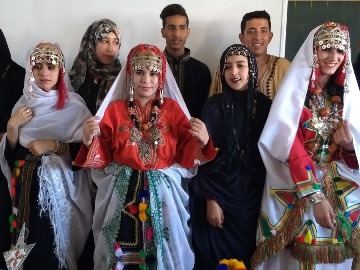 Guest Contributor
Guest Contributor
Morocco: A Marvelous Multilingual Mosaic
By Natasha Agrawal
Intricate, colorful mosaics are the hallmark of Moroccan art and architecture. Each geometrically carved tile is embedded into a larger design. Together, the tiles create astounding harmonious designs on walls of mosques, water fountains, and buildings.
I found the same harmony among the mosaic of people I met in Morocco on my International Field Experience in March, 2018. Layer upon layer of civilization has created a nation as colorful and diverse as the tiles in the mosaics in this north western corner of Africa. The name Africa itself comes from a tribe known as Ifriquiya who were the original inhabitants of the region. These tribes were later known as the “Berbers” by the Romans who invaded from Europe, making Volubilis one of their capital cities in Africa. The ruins of Volubilis dating back to first century AD, still proudly display mosaic floors, Roman arches, Corinthian pillars, and the Roman alphabet. The Romans were superseded by the Arabs, who marched across North Africa, reaching the Northwest, which they called Maghreb. Maghreb Al Asqa is the Arab name for Morocco meaning the western end of the Arab Empire. During the age of colonization, Spain, Portugal and France all laid claim to Maghreb. Morocco was a French protectorate from 1912 to 1956. To this day, the two cities of Melilla and Ceuta are under Spanish rule.
Therefore, it is no surprise to hear a multitude of languages in the vibrant souqs [markets] and streets as we traveled around. The two most important languages used are Arabic and French. Arabic has two varieties, Standard Arabic, called Fus’ha, and Moroccan Arabic called Darija. Standard Arabic is also the language of the Holy book, the Quran; and is the official language of the country. Darija is the lingua-franca of Morocco. It is widely used within friends and family circles. The French colonists brought their language to Morocco. French is taught in schools across the country and has a higher status than other languages. There are three major native Amazigh languages: Tashelhit in the south, Tamazight in the central region and Tarafit in the north. (Fatima Sadiqi, 2006). These languages have recently been introduced in schools to preserve the native identity. I was taken by complete surprise, however, when Moroccan teens began singing movie songs in perfect Hindi. Moroccan teens have roots and wings. With native Amazigh languages, they stay connected with their culture while flying East or West with French, English, Spanish, Arabic or Hindi.
English is the fastest growing language enjoying a high status in Morocco. Students are eager to learn English. Typically, English is introduced in the curriculum in 7th grade in public schools. In private schools, it can be taught as early as 2nd grade at the expense of the native Amazigh languages. The United States State Department has set up Access centers in rural Morocco where promising low-income students receive micro-scholarships for additional English instruction. Students in these centers can apply and receive funding to attend a High School in the United States for a year. We met Rachida and Yasmine, who are packing their bags to experience a year of high school in the United States in September, 2018.
The Fulbright “Teachers for Global Classrooms” program aims to create teachers and students who are globally aware and have the tools to collaborate and tackle global issues. The United Nations has outlined 17 Sustainable Development Goals that need to be embedded into the curriculum to develop students with global, problem-solving mindsets. Teachers selected for this program first complete an online course on Global Citizenship, and then travel on a Field Experience to a new country. Finally, teachers have to create a Global Education Guide to assist other teachers to globalize their curriculum.
My field experience in Morocco consisted of a wonderful mix of education and cultural trips. My in-country hosts, Meriem Lahrizi in Rabat and soft-spoken Youssef El Ouidani in Agadir, are teachers of English as Foreign Language (EFL) in high schools. From attending conferences in universities, to meeting, teaching, observing students and teachers in a variety of educational settings, Meriem and Youssef had expertly planned it all. Over many glasses of hot, bubbly, green mint tea and almond pastries, we had conversations about education, students, languages, and global issues. Within this hectic schedule, we also tried on Moroccan outfits, ate pastillas and tajines, celebrated Fridays with couscous, bargained in the souqs, gaped at the architecture, learned Arabic words, enjoyed sunsets on the Agadir beach, and, of course, took the amazing camel ride.
After my return to New Jersey, my students have “met”, virtually, students in Moroccan classrooms. Students in both classrooms have increased their awareness of each other. My students discovered that kids around the world are playing Fortnite, doing the Dab, and making soccer star albums. We are truly more alike than different. So go ahead, send in your application to Fulbright Teachers for Global Classrooms. You never know what part of the world in which you may find yourself. Inshallah!*
Natasha Agrawal, ESL Teacher, Robbins Elementary School, Trenton School District nagrawal@trenton.k12.nj.us
[Ed.: *Inshallah | Definition of Inshallah by Merriam-Webster: if Allah wills: God willing.]
